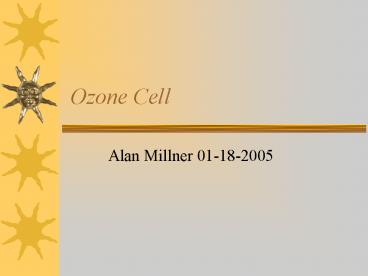Ozone Cell - PowerPoint PPT Presentation
Title:
Ozone Cell
Description:
Ozone Cell Alan Millner 01-18-2005 Review of the Field of a Pair of Oppositely Charged Plates in Vacuum By symmetry, no field outside If plates have charge Q, area A ... – PowerPoint PPT presentation
Number of Views:35
Avg rating:3.0/5.0
Title: Ozone Cell
1
Ozone Cell
- Alan Millner 01-18-2005
2
Review of the Field of a Pair of Oppositely
Charged Plates in Vacuum
- By symmetry, no field outside
- If plates have charge Q, area A, then by Gauss
Law D ?0E Q/A between plates - If separation is d, then
- V dE dQ/ ?0A or Q (?0A/d)
- If the capacitance C ?0A/d then
- Q C V
- Energy W ½ QV ½ ?0E2 (dA)
- Or, W ½ C V2
Q
-Q
A
d
3
Polarization and Dielectric Constant
- Suppose we have a polarization between the plates
P proportional to E - Gauss Law says D P ?0E Q/A
- Define dielectric constant in a material ? by
- P (? -?0) so D ? E Q/A
- So V dE dQ/ ?A , or Q CV
- where capacitance C ?A/d
- (substitute ? for ?0)
- Note W ½ C V2 ½ ? E2 (dA)
- Energy density times volume
4
Design Constraints
- Need 4E7 volts/meter across O2 to make O3
- Broad optimum around 30kHz
- Need insulating layer to avoid arc damage
- Alumina from Kyocera is good
- Need 11000 round shape factor for support
- Over 4kV becomes difficult to insulate
- Fewer larger cells are less expensive
- NOW YOU DESIGN AN OZONE CELL
5
Ozone Cell Construction
6
Equivalent Circuit
7
Ozone Cell Analysis
8
Energy
W ? vI dt W ? v (dQ/dt) dt ? vdQ For linear
C, Q CV dQ C dv W ? Cvdv from v0 to
vV W ½ C V2 Or W ½ VQ (area under curve of
V vs Q)
9
Energy in a field
- V Ed Efield/gap
- QDA Dfieldarea
- W (dA) (? EdD)
- Volume V dA
- W volume energy per unit volume V U
- If linear, D ?E and U ? EdD ½ ? E2
10
Displacement current
- I dQ/dt
- Q AD A ?E
- So I d(A ?E )/dt, I/A d(?E )/dt
- We may identify d(?E )/dt as displacement current
density - Like jI/A current density
- Note later
- ? Hdr ?? j d(?E )/dt dA
- so a loop around either current J or displacement
current d(?E )/dt - produces the same H field
11
Fringe fields
- If C Co Cfringe
- W Wo Wfringe
- Cfringe/Co Wfringe/ Wo
- If Efringe lt Eo then
- Cfringe/Co lt Vfringe/ Vo
- Vo dA
- Vfringe d2 P where P perimeter
12
Fringe fieldsexample
- Our example of a circular capacitor, radius R
- Vo d? R2
- Vfringe d2 2?R
- Vfringe/Vo 2d/R
- In our example, better than 1.
13
Field Patterns
Consider 2 dimes, arranged on an axis, 10 meters
apart, oppositely charged to 1 coulomb What
does the field pattern look like 1. within 1 mm
of the positive dime's surface? 2. one meter from
the positive dime? 3. 5meters from the axis
center? What is the field strength at each
location above?































